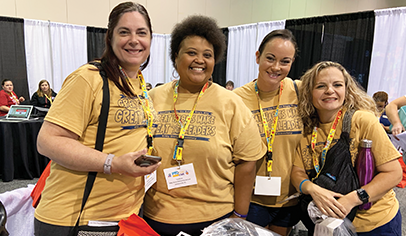What does it take to be a good PTO leader? Sure, it calls for an ability to juggle the volunteer projects and board meetings that keep the group going. But at its most basic, being a leader means knowing how to work with people to get things done. Setting aside the bylaws and to-do lists, a job description for a parent group leader might read something like this:
Wanted: Enthusiastic self-starter with strong communication and organizational skills and the ability to work well with a team. Must be open to new ideas and able to motivate others to work toward common goals. Adept problem-solver with conflict resolution skills desired. Good listener strongly preferred.
Everyone has the ability to lead, but as countless experts will tell you, leaders are made, not born. Being an effective leader requires tuning in to what’s important to parents, teachers, and staff and acting in a way that earns their respect.
“We all know people who say they’re leaders and they put themselves in leadership roles, but we all kind of roll our eyes when they’re not looking because they’re not authentic,” says Hank Rubin, author of the book Collaborative Leadership: Developing Effective Partnerships in Communities and Schools. On the other hand, he says, “some people never take the title of leader, but when they talk, everyone stops and listens, and it has a profound impact on the direction of a group.”
Sharon Rose Powell has been a leadership consultant for more than 30 years and is the founding president of the Princeton Center for Leadership Training, a nonprofit organization that serves parents, students, and school staff. “A leader has a clear vision of what they want to do and can get others excited about a common vision,” she says.
Skills such as using parliamentary procedure, creating an agenda, and facilitating discussion can be learned, but if a leader hasn’t earned the respect of those attending the meetings, she won’t be able to keep the group on track.
Building Trust
How do you earn trust and respect? “Almost the most important quality is the ability to see the big picture, for people to be more concerned about the greater good than personal gain,” says Janet Quinn, a former PTA and PTA council president now serving on the Northshore School Board in Bothell, Wash.
Good leaders should have a commitment to the whole school and not just to their own pet projects, says Stephen Poling, principal of DeGrazia Elementary School in Tucson, Ariz. “They should not just have a specific agenda or narrow view of what they want done,” he says. “It should be a partnership with [the principal] and the teachers.”
Even if you have the best of intentions, that may not come across without strong communication skills. Being a good communicator means not only keeping people in the loop but also welcoming input from others and listening to what they have to say.
“About 90 percent of problems arise from poor communication, no communication, or miscommunication,” Quinn says. “Communication is at the heart of what we do.”
Susan Masterson has worked with parent-teacher groups for most of her 20-year career as a principal. The head administrator of Madison Elementary in Janesville, Wis., and the immediate past president of the National Association of Elementary School Principals, Masterson knows a thing or two about leading an organization. “You need to have a willingness to listen to what everyone would want to say, not just what you want to hear,” she says. “There’s a real art to just being open and listening to whatever comes and not making a judgment until you’ve listened all the way through.”
A good leader creates an atmosphere of trust by facilitating discussion, asking thoughtful questions that encourage people to talk, and practicing active listening, Powell says. This technique involves repeating what you heard and asking the speaker for clarification. At the Princeton Center, trainers teach participants to use “straight talk,” Powell says—letting people know what you appreciate about them, what you need from them, and what’s getting in the way of accomplishing a goal. Leaders need to be open to hearing this kind of straight talk about their own performance, she adds.
Leaders also need to respect group members by valuing their time and following through on their commitments. Calling meetings when they need to be held and even starting and ending meetings on time demonstrate responsibility, Masterson says.
If leaders aren’t focused, efficient, and productive, people start to think that their time is being wasted or that the amount of work they put in is out of proportion to the benefits they receive, says Rubin, who serves as dean of the University of Redlands School of Education in Redlands, Calif. He recommends identifying a quick and early success that will keep people motivated. For example, don’t just keep asking parents to raise money without providing obvious benefits in return. Fund a project that people can see, whether it’s landscaping the school grounds or purchasing new field equipment for physical education classes.
“In voluntary organizations,” he says, “very often you’re experimenting with what you have to do to get people working together long enough to get the work done.”
Defining Your Leadership Style
How you work with others says a lot about your style. Are you a hands-on, take-charge leader who wants things done a certain way, like a conductor who signals to musicians what they should play and when? Or are you a laid-back, laissez-faire leader who’s comfortable improvising? Perhaps your style is somewhere in between these two extremes, and you’re a democratic leader that takes input from everyone but isn’t afraid to make an executive decision.
There is no “correct” leadership style, and each approach has advantages and drawbacks. For example, a hands-on president may get a lot done, but when she leaves office it may be difficult to transition to a new leader. A laid-back volunteer coordinator may be good at bringing new people into the group, but not as good at following through on plans. And democratic leaders who want the group to reach consensus can end up hamstrung when people just can’t agree.
Most leaders use a combination of styles and adapt their approach to the needs of a particular situation. At DeGrazia Elementary, Poling says, parent group leaders have a democratic, relational style of leadership that engages other people. “In general, it works better if they’re democratic and parents feel like they have input,” he adds.
You don’t need to have been elected most popular or most likely to succeed in high school to lead the PTO, either. While many people think of parent group leaders as individuals who are comfortable in the spotlight, Masterson says that in her experience, that’s often not the case. “Many of our volunteers and leaders don’t like the spotlight,” she says. “I’m not sure the charismatic, up-front personality is the best kind of thing because it can become an ego thing instead of being about serving others.”
Parents often step up to a leadership role because they’ve developed a network of people to help them accomplish tasks, Masterson adds, such as a room parent who can round up other parent volunteers to help with field day. Good leaders are comfortable with the fact that not everyone is like them, she continues. And in a volunteer organization, members need to feel appreciated for the contributions they make, even if it’s not how you would do it yourself.
Whatever your style of leading, you have to be able to work with different personalities and backgrounds and to resolve conflicts when they arise. Some of the conflicts in parent groups result when people have a difficult time dealing with these aspects.
Katie Wiese has more than a decade of experience with parent groups and has served as president of elementary, middle, and high school PTOs. Last year she worked with leaders from 11 other parent groups as head of the PTO council in Bloomfield Hills, Mich. “If you need everything planned out to the day and to the hour, working with someone different than that can be difficult,” she says. “You’ve got to appreciate that the other person has a whole different work style.”
Quinn served in a similar role last year as president of the Northshore PTA Council, which included representatives from 30 schools with a variety of leadership styles. Those who worked cooperatively with others, including administrators and school district staff, were the most effective at getting things done, she says.
That’s the crux of Rubin’s work in collaborative leadership—the idea that people with a common vision can accomplish more together than separately. Leaders of volunteer organizations face the same kinds of issues as presidents of large corporations or even countries, he says, but they have the additional challenge of getting people to want to do things that they don’t have to do.
“The effective collaborative leader,” he says, “is someone who can see problems or opportunities through the eyes of other people and work with them to accomplish it.”














